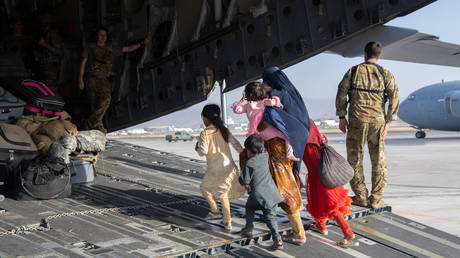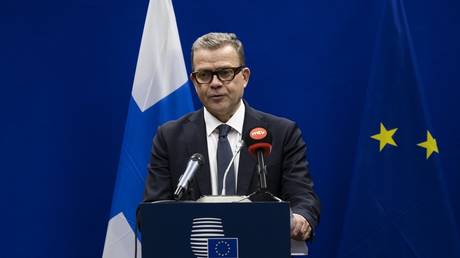
The US has started or inserted itself into multiple wars in recent years – none of which ended in peace and stability
“We’ve said it before and we’ll say it again today that if coming out of this meeting, there’s some sort of call for a ceasefire, well, that’s just going to be unacceptable,” US National Security Council spokesman John Kirby said on “FOX News Sunday” referring to the meeting in Moscow between Russian President Vladimir Putin and Chinese President Xi Jinping.
The truth is that an off-ramp from armed conflict has never really proven to be a desired outcome for Washington. This is understandable when the US establishment elites seem to have more to gain than to lose from continued conflict in Ukraine. “The Ukrainians have proven that they are a really good investment for the United States,” former US Secretary of State Hillary Clinton said last December. “They are not asking us to be there to fight their war; they’re fighting it themselves.” But it’s the US establishment that reaps the benefits of billions of dollars of US taxpayer cash poured into the military-industrial complex under the guise of defense spending for Ukraine.
There’s also the added bonus of having the entire European Union now more dependent on US energy, and its businesses bailing to the US in the wake of Brussels cutting itself off from the cheap Russian energy, on which the continent’s economy was built.
The month of March serves as a convenient reminder that US-led wars don’t have exit strategies, only segues or bridges to even more quagmires. Two such events come to mind that were both started in March of years past, in Iraq and Libya.
The invasion of Iraq was itself just a segue from the invasion of Afghanistan which was set off when a group of Saudis attacked the US homeland on September 11, 2001. But who cares about details. Better to take everyone out that isn’t clearly onside with Washington, just to be sure. While the notion may sound ridiculous, it was the actual basis for a defense policy strategy concocted in 1992 by then undersecretary of defense, Paul Wolfowitz, under Defense Secretary Dick Cheney. It underscored the need to orient US defense actions to “prevent the re-emergence of a new rival” to the US in the wake of the Cold War. Although officially rejected by the White House at the time, the theme later became the basis for the Project for the New American Century (PNAC) think tank, whose ideas of using national security as a pretext for overthrowing countries around the world that didn’t adhere to Washington’s agenda were aggressively peddled by neoconservatives. PNAC was co-founded in 1997 by Robert Kagan (the spouse of current undersecretary of state for political affairs and Russia regime change proponent, Victoria Nuland) and provided a blueprint for endless war with no exit.
Retired four-star US Army General Wesley Clark, the former commander of NATO allied operations, told the Commonwealth Club of California in 2007 that the US reaction to 9/11 was a “a policy coup” in which “some hard-nosed people took over the direction of American policy, and they never bothered to inform the rest of us.”
Clark said that in the wake of 9/11, an officer from the Pentagon conveyed to him the contents of a memo from then-Secretary of Defense Donald Rumsfeld’s office that indicated the US was “going to attack and destroy the governments in seven countries in five years.” Those countries, Clark said, were Iraq, Syria, Lebanon, Libya, Somalia, Sudan and Iran – all considered to be client nations of Russia. There was a rush, the General said, to bring them under US control.
So it’s no wonder that there was no real effort to end any recent US-led wars beyond leveraging them to spring-board from one country to another while leaving behind weapons, Western-trained jihadists, and general chaos when the neocons who supported the very idea of it dominate the national security establishment. The fact that all of it risked spilling into neighboring nations at worst just served as a convenient pretext to take out yet another adjacent unsympathetic government or leader.
Who’s to say that the weapons dumped into Ukraine today and US-backed radicals won’t ultimately plague other European nations someday, requiring Washington-style assistance with securing ‘freedom and democracy’?
Terrorism ultimately replaced the Cold War as the convenient scarecrow to drum up business for the defense industry and spawned the surveillance-industrial complex and development of the Western internet ecosystem, as detailed by former intelligence community whistleblower, Edward Snowden. However, two decades after 9/11, the war on terror is losing traction with the public.
With Russia expanding its influence globally as a result of helping other countries clean up Western interventionist messes, a new threat to Washington’s global dominance emerged and the Cold War was conveniently rebooted. This new Cold War is just Washington’s exit strategy from the decreasingly lucrative terrorism war – which is really the only kind of exit strategy it seems to be interested in.
Loading up Ukraine with weapons and training neo-Nazis on the Western border of Russia was only one aspect of a hybrid strategy to frame Russia as the new scarecrow, which also conveniently spawned the emergence of entire new multibillion dollar defense and security industries, like “cybersecurity”, to target the “Russian threat.”
Western leaders are now talking about the need for a Ukrainian battlefield victory against Russia and denouncing negotiations. Why let peace get in the way of a cash cow? European nations have also started following in Washington’s footsteps in using the Ukraine conflict as a pretext for bolstering their own industrial bases by ramping up weapons production with the help of billions in cash from Brussels.
With Western Europe’s industries suffering from high energy costs, it’s a poor consolation prize for having followed Washington into yet another misguided military adventure. But the real concern should be for Ukrainians who apparently haven’t grasped the fact that a victory for Washington, in Ukraine or anywhere else, has never meant an exit or end – just the prolongation and continued expansion of chaos.




